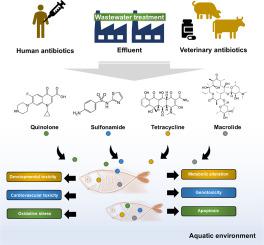Comparative Biochemistry and Physiology C: Toxicology & Pharmacology ( IF 3.9 ) Pub Date : 2020-07-05 , DOI: 10.1016/j.cbpc.2020.108840 Changwon Yang 1 , Gwonhwa Song 1 , Whasun Lim 2

|
Antibiotics are widely used in the treatment of human and veterinary diseases and are being used worldwide in the agriculture industry to promote livestock growth. However, a variety of antibiotics that are found in aquatic environments are toxic to aquatic organisms. Antibiotics are not completely removed by wastewater treatment plants and are therefore released into aquatic environments, which raises concern about the destruction of the ecosystem owing to their non-target effects. Since antibiotics are designed to be persistent and work steadily in the body, their chronic toxicity effects have been studied in aquatic microorganisms. However, research on the toxicity of antibiotics in fish at the top of the aquatic food chain is relatively poor. This paper summarizes the current understanding of the reported toxicity studies with antibiotics in fish, including zebrafish, to date. Four antibiotic types; quinolones, sulfonamides, tetracyclines, and macrolides, which are thought to be genetically toxic to fish have been reported to bioaccumulate in fish tissues, as well as in aquatic environments such as rivers and surface water. The adverse effects of these antibiotics are known to cause damage to developmental, cardiovascular, and metabolic systems, as well as in altering anti-oxidant and immune responses, in fish. Therefore, there are serious concerns about the toxicity of antibiotics in fish and further research and strategies are needed to prevent them in different regions of the world.
中文翻译:

对暴露于抗生素的鱼的毒性的综述。
抗生素被广泛用于治疗人类和兽医疾病,并且在世界范围内被广泛用于农业行业以促进畜牧业的发展。但是,在水生环境中发现的多种抗生素对水生生物有毒。抗生素没有被废水处理厂完全清除,因此被释放到水生环境中,由于它们的非目标作用,引起了对生态系统破坏的担忧。由于抗生素被设计为在体内持久且稳定地起作用,因此已经在水生微生物中研究了其慢性毒性作用。但是,在水生食物链顶部的鱼类中抗生素的毒性研究相对较差。本文总结了迄今对鱼类(包括斑马鱼)中抗生素的毒性研究的最新了解。四种抗生素类型;据报道,喹诺酮类,磺酰胺类,四环素类和大环内酯类对鱼类具有遗传毒性,据报道会在鱼类组织以及河流和地表水等水生环境中生物蓄积。已知这些抗生素的不良作用会导致鱼类的发育,心血管和代谢系统受损,并改变抗氧化和免疫反应。因此,人们对抗生素对鱼类的毒性存在严重的关注,需要进一步的研究和策略来防止抗生素在世界不同地区的使用。据报道,被认为对鱼类具有遗传毒性的大环内酯类和大环内酯类会在鱼类组织以及河流和地表水等水生环境中生物蓄积。已知这些抗生素的不良作用会导致鱼类发育,心血管和代谢系统受损,并改变抗氧化和免疫反应。因此,人们对抗生素对鱼类的毒性存在严重的关注,需要进一步的研究和策略来防止抗生素在世界不同地区的使用。据报道,被认为对鱼类具有遗传毒性的大环内酯类和大环内酯类会在鱼类组织以及河流和地表水等水生环境中生物蓄积。已知这些抗生素的不良作用会导致鱼类的发育,心血管和代谢系统受损,并改变抗氧化和免疫反应。因此,人们对抗生素对鱼类的毒性存在严重的关注,需要采取进一步的研究和策略来防止在世界不同地区使用抗生素。和代谢系统,以及改变鱼的抗氧化和免疫反应。因此,人们对抗生素对鱼类的毒性存在严重的关注,需要进一步的研究和策略来防止抗生素在世界不同地区的使用。和代谢系统,以及改变鱼的抗氧化和免疫反应。因此,人们对抗生素对鱼类的毒性存在严重的关注,需要进一步的研究和策略来防止抗生素在世界不同地区的使用。



























 京公网安备 11010802027423号
京公网安备 11010802027423号